THE
UNMUTUAL PRISONER VEHICLE GUIDE
THE
LOTUS 7
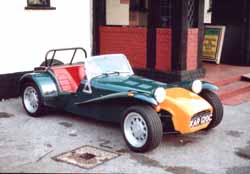 Photos:
Steve Dix, Dave Healey, Mathew Lock, Rennie Chivers, Paul White, Brian. Text:
Steve Dix, Paul White, and Rick Davy.
Photos:
Steve Dix, Dave Healey, Mathew Lock, Rennie Chivers, Paul White, Brian. Text:
Steve Dix, Paul White, and Rick Davy.
IN THE PRISONER:
Number Six's car, registration KAR 120C, which he "built with
his own hands". Can be seen in the series opening titles, and extensively
in the episodes "Many Happy Returns", "Do Not Forsake Me",
and "Fall Out".
IN REALITY: Thrtee diffent Lotus 7 cars were used during the making of the series.
The
Lotus 7 was originally designed as a replacement for the Lotus 6, a basic
racer that was the origins of the Lotus brand. Designed by Lotus's Colin Chapman,
the 7 (like most Lotuses) made use of stock Ford, Triumph and other motor
vehicle components in innovative ways to produce a performance car with exceptional
handling. The Lotus 7, which first came out in 1957, was always referred to
as a "Bread and Butter" car, as sales of the car kept the company
solvent during the financially-draining development of the Lotus Elite.
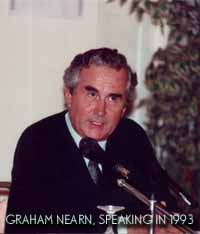 A Lotus 7 is featured throughout the opening titles of the series, and again in
the episodes "Many Happy Returns", "Do Not Forsake Me Oh My
Darling", and "Fall Out".
A Lotus 7 is featured throughout the opening titles of the series, and again in
the episodes "Many Happy Returns", "Do Not Forsake Me Oh My
Darling", and "Fall Out".
Patrick McGoohan had originally been
asked to use a Lotus Elan for the series (and later used one for "The
Girl Who Was Death" car chase, see below) but upon visiting the Lotus
headquarters at Cheshunt, decided on the Lotus 7 instead.
Caterham
Director Graham Nearn (speaking to Dave Jones in 1993) recalled these early
meetings:
"Patrick.......was
looking for an individual car; something that portrayed this idea of freedom.
The word he used was 'maverick' which I think described it quite well. Something
that, sort of, goes with the herd but is different and runs along side when
it feels like it. Lotus......they were keen for him to have the Lotus Elan.....it
was running in "The Avengers" series at the time, but there was
no way Patrick wanted that. He saw the Seven in the yard and said "That's
the car I want"". Click HERE
to read this interview in full.
In 1991, Patrick McGoohan confirmed this:
"Back
in 1966 when we were preparing The Prisoner series, we needed a car forour hero.
Something out of the ordinary. A vehicle to fit his personality. The first time
I saw the now-familiar KAR 120C, I had that certain feeling. It sort of looked
me straight in the eye. I test drove it. This was it. A symbol of all The Prisoner
was to represent; standing out from the crowd, quickness and agaility, independence
and a touch of the rebel."
There are no fewer than THREE Lotus 7 cars used in the series.
The first "Prisoner"
Lotus 7 is a very difficult car to pin down. There exist a number of pictures
of the car at the end of a line of Elans at the old works factory in Cheshunt
(long before the company's move to Hethel). However, the "KAR 120C"
number plate was often moved between demonstrators.
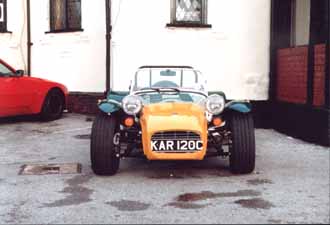 The
"KAR 120C" used in the original filming was a Lotus Super 7 series
II, which was sold abroad (Australia) in early 1967 (after the filming of "Many
Happy Returns") and later written off in a racing accident. This car featured
a Ford pre-Xflow 1500 engine specially tuned by Cosworth.
The
"KAR 120C" used in the original filming was a Lotus Super 7 series
II, which was sold abroad (Australia) in early 1967 (after the filming of "Many
Happy Returns") and later written off in a racing accident. This car featured
a Ford pre-Xflow 1500 engine specially tuned by Cosworth.
The "Do Not Forsake
Me Oh My Darling" model, actual registration LC K88D, was owned by a local
man from Borehamwood (Frank Rycroft) who provided the car to the production crew and later sold the car to the Barnet Motor Company.
The "Fall Out" model is actually an earlier normal 7 (with Ford 100E engine)
specially altered by Lotus to look like a Super Seven.
Graham Nearn was one of
the owners of an independent car dealer and service garage in Caterham on the
Hill, Surrey which was appointed as a Lotus Centre in 1959 by Lotus. The company
was called Caterham Car Sales & Coachworks. Gradually, the other joint owners
left the company and Nearn took full control. When he took over the rights to
the Lotus Seven in 1973, he used another company name to do so - Seven Cars
Ltd. Nearn can be seen in "Fall Out" driving the 7 up to Number Six's London
home.
The Registration
"KAR 120C" is now owned by Caterham Cars, and sits proudly on the
first 'Prisoner' series car (see below).
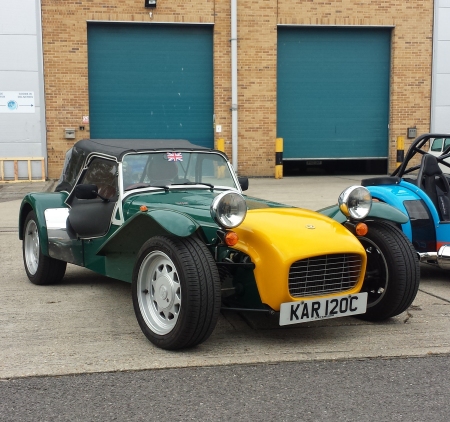
Photo (c) Paul White.
The Lotus
7 SII didn't have indicators, or a petrol gauge. Petrol was checked with a supplied
dipstick. If you wanted to fill the tank, you had to remove everything from
the luggage area to get at the filler cap. Indicators and an external filler
cap were added on the SIII, so you could pour petrol on your shoes instead of
your luggage. The SII did have a speedometer (which earlier cars didn't) but
it was in front of the passenger, and so not easily readable by the driver.
The modern
Caterham 7 closely resembles the late 1960's Lotus 7 series III. The series
IV was a radically-redesigned car, and was originally taken over by Caterham
when Lotus decided the car was no longer viable. Unfortunately, the series IV's
high reliance on moulded fibreglass components caused problems with production,
and so in 1973 Caterham reverted to the Series III design. Not only was the
Series lV laborious to manufacture because of the fibreglass body but there
were 3 other main factors: a) Some of the parts for the Series lV that Nearn
inherited from Lotus were beginning to dwindle. The high volume re-ordering
necessary to obtain new stock of parts would have placed a huge financial burden
on the fledgling company. b) The secondhand demand for the Series lV was not
very good compared to the previous Series lll, ll & l which meant that the
residual value of the Series lV dropped. This made it less attractive in the
showroom. Harder to sell one from new. c) Graham Nearn can best answer this
one in an interview from 1986:"We let it be known that we had enough
spares to make a limited number of Series 3s, ...and the phone never stopped
ringing!"
.
In the early
1990s, Caterham Cars produced a Limited Edition Prisoner Series 7 , which included
a dashboard-based plaque with Patrick McGoohan's signature embossed upon it. Patrick McGoohan was given car Number 6 from this range when he attended the Motor Show launch of the car at Birmingham's NEC (where he was interviewed by Simon Bates for Radio 1, and in-depth by Howard Foy, an interview now available on CD HERE).
This Caterham car was passed to his son-in-law by Patrick and to this day still remains with the family.
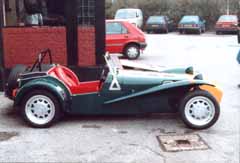
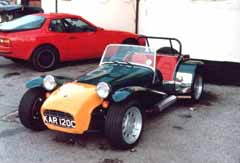
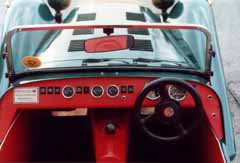
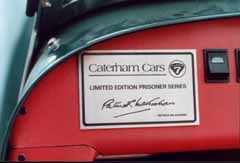
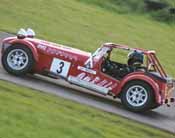
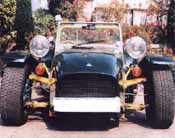 The
Seven-style kit car has also proven ever-popular. Westfield, Sylva (see photo,
left, of Steve Dix's Sylva 7 Striker in front of the Chess Lawn in Portmeirion)
and a number of other kit builders produce seven-style vehicles, price depending
on how much work the builder wants to do himself, from near road-ready models
such as the Caterham, right to the most basic design, which is provided as a
set of plans where the builder must fabricate nearly everything! Much of Caterham's
business now comes from 7 racing (thanks to Mathew Lock for the photo, far left,
of one such 7). But although Caterham provides a large number of cars to the
motorsport market (for circuit racing, hillclimbs and sprints), it also has
a full order book from general road users as well who use the cars for Sunday
morning blasts, weekends away, holidays and trips over to the continent.
The
Seven-style kit car has also proven ever-popular. Westfield, Sylva (see photo,
left, of Steve Dix's Sylva 7 Striker in front of the Chess Lawn in Portmeirion)
and a number of other kit builders produce seven-style vehicles, price depending
on how much work the builder wants to do himself, from near road-ready models
such as the Caterham, right to the most basic design, which is provided as a
set of plans where the builder must fabricate nearly everything! Much of Caterham's
business now comes from 7 racing (thanks to Mathew Lock for the photo, far left,
of one such 7). But although Caterham provides a large number of cars to the
motorsport market (for circuit racing, hillclimbs and sprints), it also has
a full order book from general road users as well who use the cars for Sunday
morning blasts, weekends away, holidays and trips over to the continent.
In 2005, Octane Magazine ran a 6-page feature on the Prisoner 7 - click HERE
for more info and exclusive images.
Several
"Prisoner" fans are of course Caterham 7 owners, and many have Prisoner-related
numberplates such as the following formerly owned by Paul White;
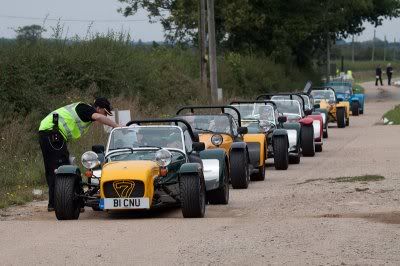
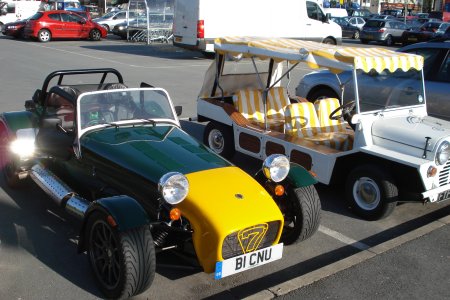
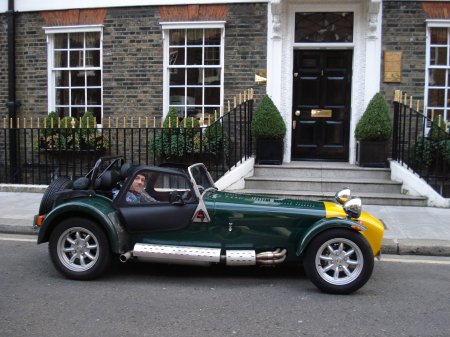
And the
following Caterham owned by Rennie Chivers which was built by Simon Nearn (Graham's
son);
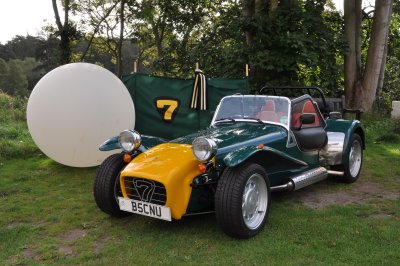
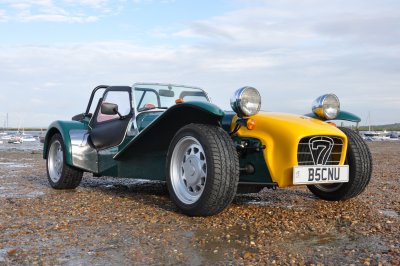
And the
following Westfield 7 by Brian from Canada;
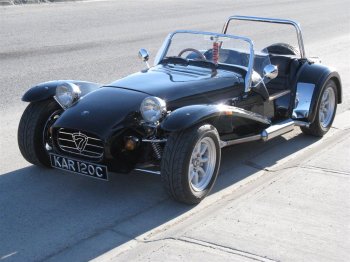
Thanks to
Unmutual Website reader Steve Brant, here is a link for 1:24 kit models of the
Lotus 7, but stocks are very limited as Tamiya no longer have them in stock:
https://www.monstersinmotion.com/cart/item-list-pt-c-13_194/prisoner-tv-series-lotus-super-7-series-ii-sportscar-124-scale-model-kit-by-tamiya-japan-p-28712.html
In 2013,
writes Paul White; "Caterham Cars have now moved lock, stock and barrel
from the Surrey town that gave them their name.
The company with Graham Nearn at the helm has had an association with the town
for over 50 years. The
company premises were originally based up Caterham Hill (Townend) just out of
the main town where the business was established as an agent to sell Lotus cars.
In 1973 when Colin Chapman sold the rights of the Lotus 7 to the Nearn family,
the premises were adapted to both build and sell the cars. This continued until
1987 when the need to expand and the arrival of Hurricane Gilbert in October,
forced the firm to find a new premises for the manufacturing of the 7 in Crayford
(near Dartford), Kent. Cars were sold on the Caterham Hill (Townend) site but
from a nearby house until the showroom was refurbished after damage inflicted
by the storm. In 1996 the showroom was moved down the hill into the centre of
the town by the railway station where it has remained until the end of February
2013. The Station Avenue site has been sold by the landowners and the garage
will be demolished to make way for 35 retirement flats, due to be built by developers
Churchill Retirement Living, by May 2014. The Caterham South showroom has moved
to a temporary location in Crawley, West Sussex pending the establishment of
more permanent premises."
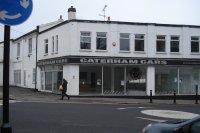
Click
here to return to the Unmutual Vehicle Guide
Click
here to return to the Unmutual home page
 Photos:
Steve Dix, Dave Healey, Mathew Lock, Rennie Chivers, Paul White, Brian. Text:
Steve Dix, Paul White, and Rick Davy.
Photos:
Steve Dix, Dave Healey, Mathew Lock, Rennie Chivers, Paul White, Brian. Text:
Steve Dix, Paul White, and Rick Davy. A Lotus 7 is featured throughout the opening titles of the series, and again in
the episodes "Many Happy Returns", "Do Not Forsake Me Oh My
Darling", and "Fall Out".
A Lotus 7 is featured throughout the opening titles of the series, and again in
the episodes "Many Happy Returns", "Do Not Forsake Me Oh My
Darling", and "Fall Out".  The
"KAR 120C" used in the original filming was a Lotus Super 7 series
II, which was sold abroad (Australia) in early 1967 (after the filming of "Many
Happy Returns") and later written off in a racing accident. This car featured
a Ford pre-Xflow 1500 engine specially tuned by Cosworth.
The
"KAR 120C" used in the original filming was a Lotus Super 7 series
II, which was sold abroad (Australia) in early 1967 (after the filming of "Many
Happy Returns") and later written off in a racing accident. This car featured
a Ford pre-Xflow 1500 engine specially tuned by Cosworth. 





 The
Seven-style kit car has also proven ever-popular. Westfield, Sylva (see photo,
left, of Steve Dix's Sylva 7 Striker in front of the Chess Lawn in Portmeirion)
and a number of other kit builders produce seven-style vehicles, price depending
on how much work the builder wants to do himself, from near road-ready models
such as the Caterham, right to the most basic design, which is provided as a
set of plans where the builder must fabricate nearly everything! Much of Caterham's
business now comes from 7 racing (thanks to Mathew Lock for the photo, far left,
of one such 7). But although Caterham provides a large number of cars to the
motorsport market (for circuit racing, hillclimbs and sprints), it also has
a full order book from general road users as well who use the cars for Sunday
morning blasts, weekends away, holidays and trips over to the continent.
The
Seven-style kit car has also proven ever-popular. Westfield, Sylva (see photo,
left, of Steve Dix's Sylva 7 Striker in front of the Chess Lawn in Portmeirion)
and a number of other kit builders produce seven-style vehicles, price depending
on how much work the builder wants to do himself, from near road-ready models
such as the Caterham, right to the most basic design, which is provided as a
set of plans where the builder must fabricate nearly everything! Much of Caterham's
business now comes from 7 racing (thanks to Mathew Lock for the photo, far left,
of one such 7). But although Caterham provides a large number of cars to the
motorsport market (for circuit racing, hillclimbs and sprints), it also has
a full order book from general road users as well who use the cars for Sunday
morning blasts, weekends away, holidays and trips over to the continent.





